Tourism in Alexandria offers a unique experience, unlike any other destination in Egypt. This city stands out with its distinct location, history, climate, atmosphere, and social life. It is a place that will appeal to travelers who appreciate the past and present, as the former capital of Ancient Egypt in the Ptolemaic era largely lives on evocations of its history.
Alexandria is the ideal destination for inspiring writers, as its history and culture offer endless inspiration. As a great port metropolis, Alexandria is open to the sea and is increasingly recovering its heritage and putting it in the best possible value. It is known as ‘the Pearl of the Mediterranean’, attracting visitors from all over the world. This page is dedicated to helping you discover what to see in Alexandria, whether you are interested in exploring Greco-Roman culture or other more current attractions. You can contact Egipto Exclusivo for a tailor-made trip to Alexandria, with complete vacations in which this city is the epicenter, or a day trip from other parts of the country. Our team of professionals is always at your service, ready to organize the best tourism experience in Alexandria.
Alexandria’s location greatly influences its climate as it is located on the Mediterranean coast and was for many centuries one of the most important ports in the region. The city is situated at the northwestern end of the Nile Delta, although none of the river’s branches pass through the city anymore. The closest existing branch today, the Rosetta, is approximately 60 km to the east. Alexandria is around 200 km away from Cairo.
The city has a Mediterranean climate which is warmer than countries on the European shore of the sea, but more temperate and pleasant than most Egyptian cities, particularly those located outside the Nile Delta. These are the most notable climatic features that tourists should be aware of:
Therefore, tourists will need to take the same precautions against the sun as they would in any other Mediterranean holiday destination.
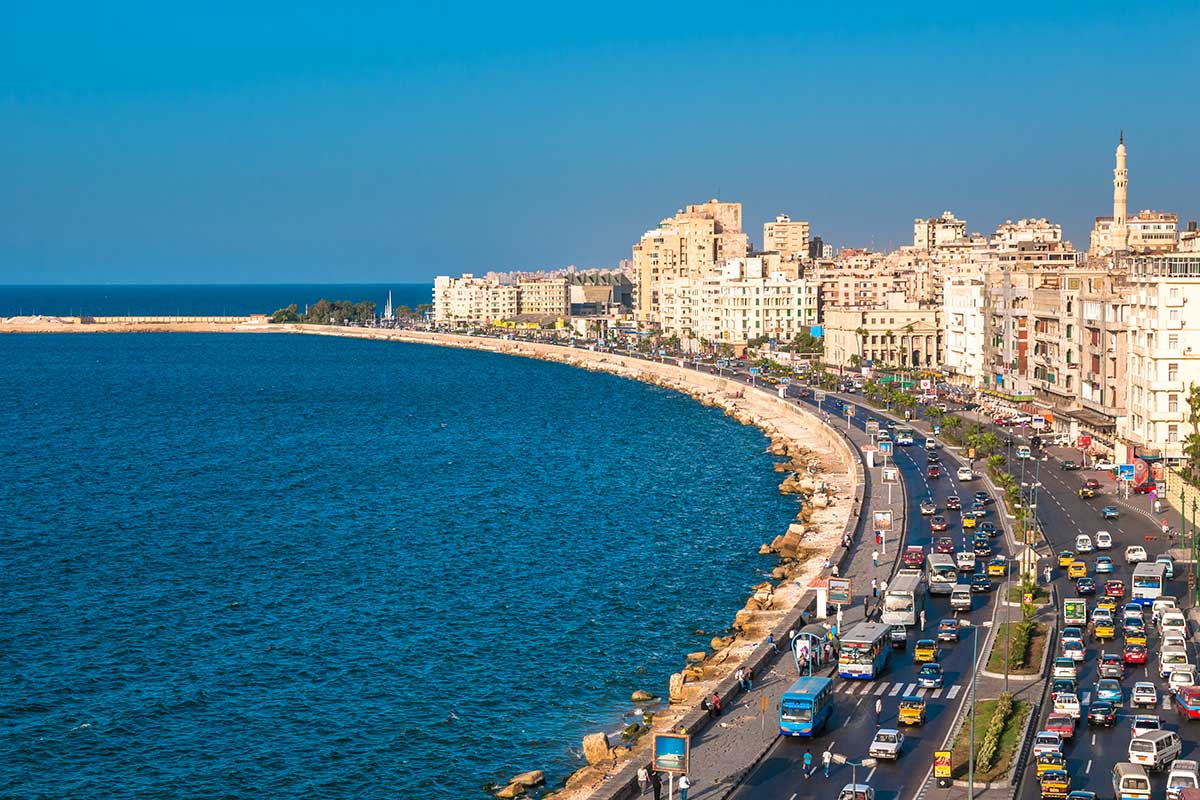
When it comes to tourism in Alexandria, it is very important to know its history, even if only in broad strokes, as we will do in these lines. Why? Simply because it differs greatly from the history of Ancient Egypt: here we will not talk about great pharaohs, as in the rest of the country. Instead, great Greco-Roman figures, Coptic Christianity, and of course, Arab civilization, gain great notoriety. In addition, Alexandria developed a very special character during the 19th century and the first half of the 20th century, which it wants to regain in the 21st century with the increase in tourism in Alexandria.
In Alexandria, everything began with Alexander the Great, as his name suggests. The great Hellenic emperor founded this city in 331 BC, during his war against the Persian king Darius III. He had arrived a year earlier, triumphant from his campaigns in the Near East and acclaimed as the liberator of Egypt. He adopted the title of pharaoh and became involved in the local culture, as evidenced by his visits to ancient Thebes (now Luxor) and the Siwa Oasis Oracle.
He believed that Egypt should open up to the Mediterranean world, making better use of its vast coastline, something it was not doing enough of. So he decided to create this port city out of nothing. And although Alexander the Great’s stay was brief, as he left the same year to conquer Persia, his seed germinated and his memory never faded. In fact, after his death in Babylon in 323 BC, his body was brought in a gold coffin to this city, and it is known that several Roman emperors paid their respects to him… but it was later lost. Perhaps in the 3rd or 4th century, during some episode of unrest, or it was hidden in a safer secret place. But the truth is that it has never been found, despite the current archaeologists’ unrelenting efforts. For some, it has become a kind of Holy Grail of modern archaeology, and if discovered, the media impact could be comparable to that of Tutankhamun’s tomb, undoubtedly boosting tourism in Alexandria.
The Alexandria of that time was a prosperous city, key in the commercial routes between Europe and Asia. It was also a city of high culture, where wisdom was protected like a valuable present and future treasure. This was demonstrated by the city’s main constructions. The famous Lighthouse, one of the Seven Wonders of the Ancient World, not only served as a luminous reference for merchant ships but was also a metaphor for the height of the city. The Museum (or Museion), an educational and cultural building that also served as a residence for the Ptolemaic dynasty, was so named because it was conceived as a true container of knowledge, dedicated and protected by the Muses. And in this great complex was located the Library, the most important in Antiquity, with more than half a million manuscripts. Legend has it that all the ships that arrived at the port had to “pay the toll” of presenting a book to be copied here. Unfortunately, it was lost, and those who come to Alexandria as tourists have to settle for the New Library, from the late 20th century.
During the Roman domination, after Cleopatra’s suicide in her Alexandrian palace, the city maintained its importance. With Egypt becoming one of the granaries of the Empire, this was the great port of departure for goods and also a wealthy financial center where several hundred thousand inhabitants resided. However, perhaps the great legacy of the Roman and Byzantine era was Coptic Christianity, as this city played a fundamental role in the consolidation and dissemination of this religion, being home to key figures such as Saint Mark or Saint Catherine. The Jewish population, for its part, had already been established in the city for several centuries, attracted by the tolerance and prosperity of the Ptolemaic era.
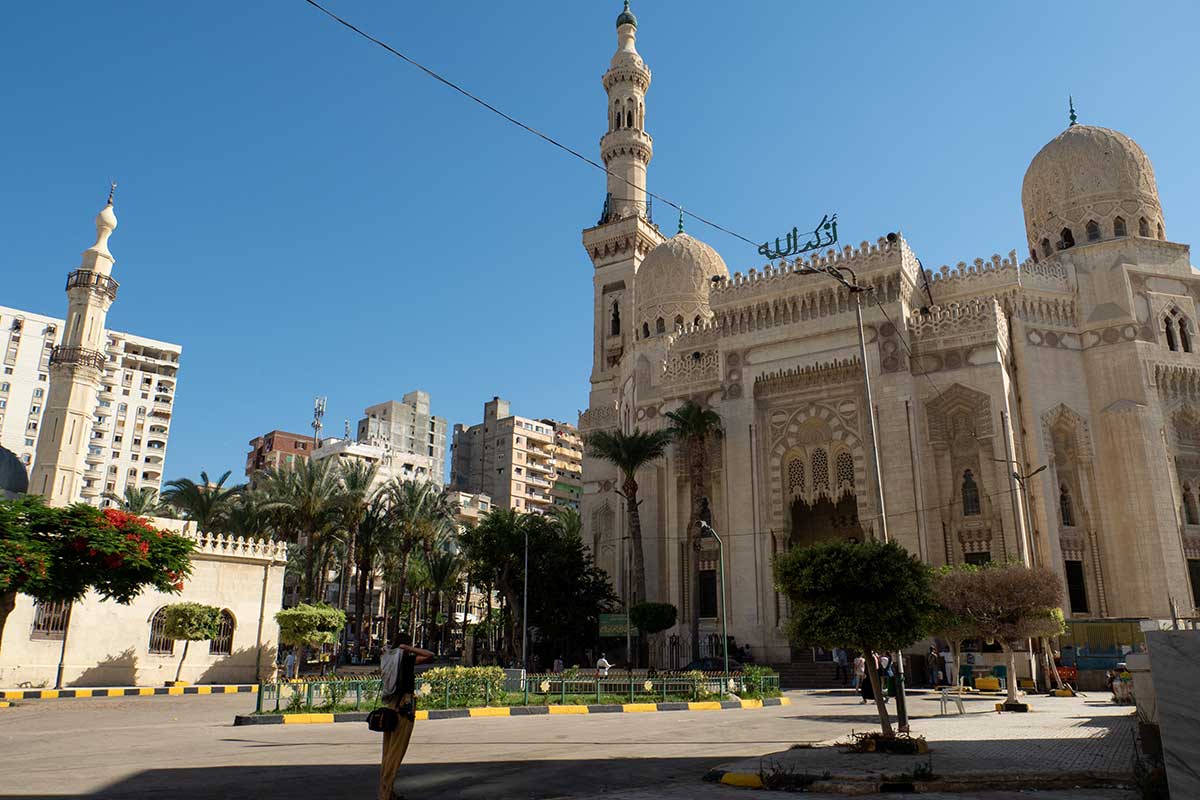
Alexandria, like the rest of Egypt, was conquered by the powerful Arab armies, but not as quickly as other cities. It was in 642, after more than a year of siege. Thus, a city full of palaces, theaters, gardens, and other places that allowed us to imagine this city as one of the most advanced in the world from a modern point of view, fell.
The destruction of the Library of Alexandria is usually attributed to this conquest, but it is more likely that this had already happened some time before, perhaps due to natural disasters and local tensions. However, Alexandria did not regain its past splendor and was plagued by attacks by pirates and crusaders.
Only a certain period during the Middle Ages, when Venice dominated international trade and Alexandria played a strategic role for the merchants of the Serene Republic, who found resonance with the Mamluk sultans who ruled the country, should be mentioned. But luck changed when the Portuguese discovered and exploited the Cape route in the late fifteenth century. Shortly thereafter, Alexandria and the rest of Egypt were conquered by the Turks, who to some extent prioritized the port city of Rosetta.
Due to its strategic importance, Alexandria and its surroundings were the site of naval battles between the French under Napoleon and the British led by Admiral Nelson. Diving to the bottom of the sea and discovering the remains of those battles is, as we will see, a surprising tourism activity in Alexandria. The latter ultimately emerged victorious, securing a position of influence over the new rulers. This was the era of the Vali of Egypt, Mehmet Ali, on behalf of the Turkish sultan, who promoted large industrial projects in the city, especially a large shipyard.
Behind this were major foreign investors and engineers, mainly French and British, who found an open, cosmopolitan, and flourishing city here. Multiculturalism was one of its main hallmarks, with numerous and populous communities of different origins, particularly Greek and Jewish. This continued until the first half of the 20th century, and the best testimony of this was the great literary works that important writers produced here, especially Lawrence Durrell’s Alexandria Quartet, another attraction for tourists coming to Alexandria.
However, Arab-Israeli tensions in the Middle East and the socialist revolution of 1952 led to the departure of many foreigners from the city and a slowdown in the arrival of new ones. In contrast, the local population began to grow exponentially, like the rest of the country, up to the present day.
In modern times, Alexandria has a population of approximately 5 million people, making it one of the most densely populated cities in the Nile Delta region. Although the city’s multicultural atmosphere has waned over time, tourism has emerged as a key driver of change.
Local authorities have recognized the potential of Alexandria’s rich historical legacy and have invested heavily in the preservation and promotion of its Greco-Roman heritage. This has become a major point of differentiation for the city, setting it apart from other tourist destinations in Egypt. In addition to its cultural appeal, Alexandria’s western port is a vital hub for the country’s foreign trade operations, handling almost two-thirds of all such activity.
Although Alexandria was once a splendid city, modern-day tourists will not find clearly defined historical neighborhoods like those in Cairo. The city has experienced significant economic and demographic growth in the last two centuries, leading to the loss of many historical relics. Unfortunately, this loss began much earlier due to natural disasters and rising sea levels by 6 to 8 meters in two millennia, which have caused some of its riches to be submerged.
However, the city’s main artery is its over 20-kilometer-long Corniche, a seafront promenade with heavy traffic. The area with the highest concentration of attractions is around the eastern port, which was once the city’s main port. The two most famous landmarks of modern-day Alexandria’s tourism are located on the jetties: the Qaitbay Citadel (where the Lighthouse once stood) and the New Library of Alexandria. The city center, where visitors can get a real sense of Alexandria’s pulse, is located between them and inland.
Despite the absence of clearly defined neighborhoods, Alexandria’s tourism attractions are spread throughout the urban area. We’ve grouped them by theme below for easier navigation.
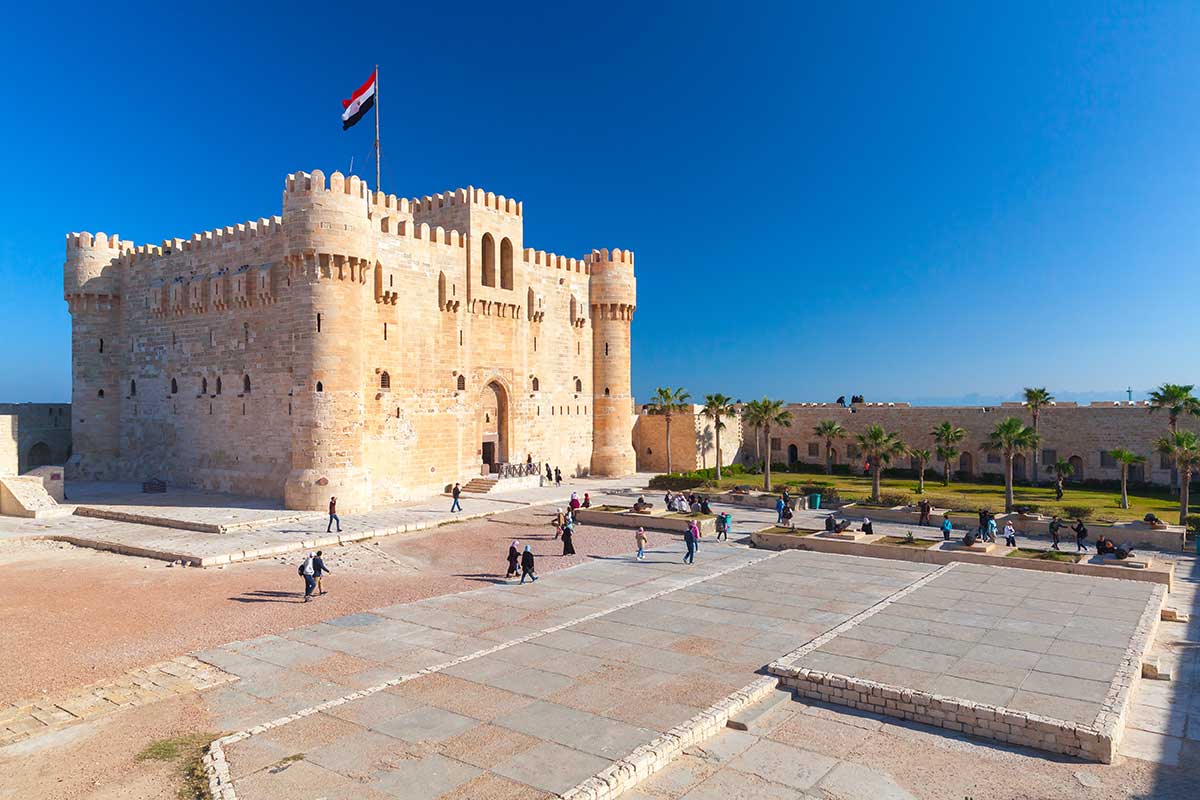
For tourists visiting Alexandria, two major landmarks to visit are the Citadel of Qaitbay and the New Library of Alexandria. These two structures pay homage to the ancient city’s famous Lighthouse and Library, respectively.
The Citadel of Qaitbay, also known as Qaitbay Fort, is a well-preserved and stunning defensive fortress with bastions and a spacious interior. Constructed during the Mamluk period in the late 15th and early 16th centuries, it served as protection against the Ottoman Empire’s threat, which later captured the city and country. The fort also provided extra security for ships docking at the port, and it was erected on the site of the Lighthouse on Pharos Island. The Lighthouse was a massive structure, more akin to a modern skyscraper than a simple signaling tower, which had been in ruins for centuries due to natural disasters like the 1303 earthquake.
The Ottomans recognized the strategic value of the citadel and maintained its operation. Similarly, Napoleon also appreciated the use of such fortresses during his invasions, and later Governor Mehmet Ali initiated a significant rehabilitation project. The citadel suffered substantial damage from British ship attacks at the end of the 19th century, but underwent numerous restorations during the 20th century.
Visitors can explore various areas of the citadel, including its tower, rooms with different purposes, courtyard, and mosque, which is no longer used for worship. The citadel is also home to two museums, one featuring marine life and another designed as an aquarium.
In addition to its historical and cultural significance, the Citadel of Qaitbay is a highly recommended destination for tourists visiting Alexandria, as it provides some of the most stunning panoramic views of the city center and its port.
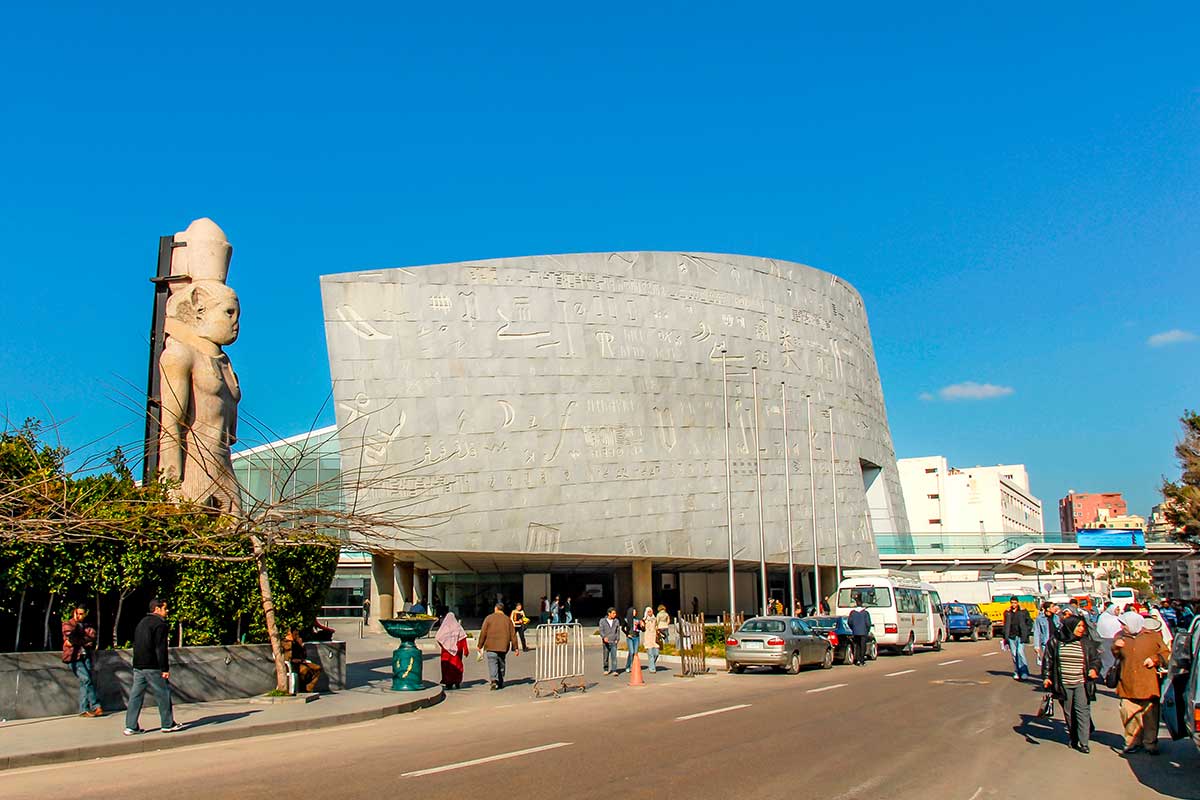
The New Library of Alexandria, also known as Bibliotheca Alexandrina, was an ambitious project of the 1990s, involving the construction of a new building with a cutting-edge style next to the promenade where the ancient Library once stood. The Norwegian architecture firm Snøhetta designed the library, which is made of cement, granite, and glass. During the construction, some remnants of the ancient Library, such as Greek-style mosaics and sculptures, were discovered. The ancient Library was an institution that achieved several scientific milestones, such as calculating the circumference of the Earth and developing astronomical maps.
The New Library is not only designed to contain books and other pieces, but it is also a space for visits and events, such as the Alexandria International Book Fair, which attracts a lot of tourism to Alexandria. It houses several hundred thousand books and tens of thousands of maps, among other collections. The library is a symbol of cultural revival, and its construction represents the city’s desire to reclaim its status as a center of knowledge and learning.
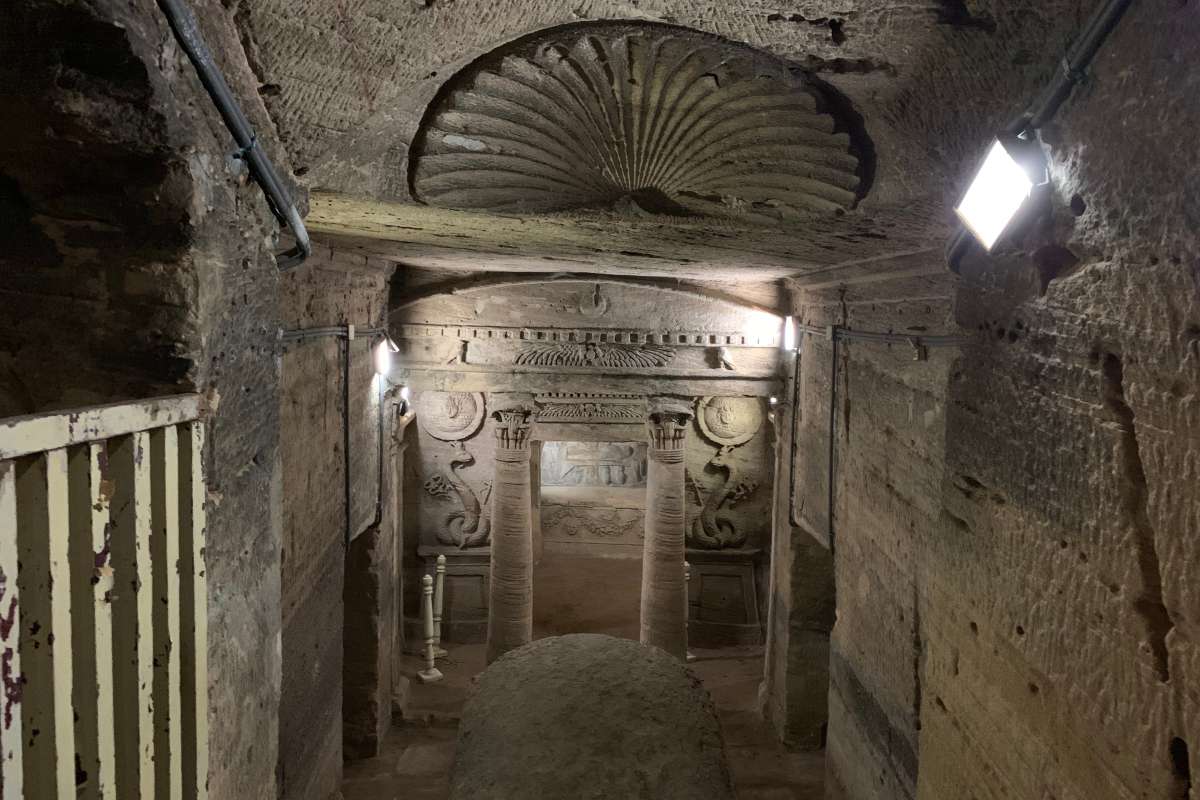
While the memories of the Lighthouse and the Library may now only be evocative, there are many other Greco-Roman remnants scattered throughout the city of Alexandria. Some of these are in excellent condition and are a must-visit for tourists, while others are still waiting to be excavated, as it is known that there is a significant underground heritage in the city.
One of the highlights is the Catacombs of Kom al-Sufaga, which were discovered quite accidentally when a donkey fell into them. These catacombs are named after the humble district where they are located, which offers little on the surface but hides an incalculable wealth underground. The complex is from the Roman era and consists of three levels of tombs carved into the rock, including tricliniums for funeral celebrations and a central chamber. There are also loculi or small niches with hundreds of burials. One of the most interesting aspects of these catacombs is the surprising blend of Roman and Egyptian iconography in the decoration, which perhaps gives greater solemnity to the place. There are figures representing the Egyptian god of death, Anubis, in the form of a Roman legionary, bearded reptiles in Greco-Roman style, Greek Medusas with snakes for hair, and more.
The Catacombs of Kom al-Sufaga are just one of several subterranean funerary complexes in Alexandria. While they are a popular tourist destination, there are others that are equally fascinating but not typically included in standard tour itineraries. These sites provide insight into the burial customs of the ancient Alexandrians, including the necropolis of Anfushi, where tombs with painted walls depicting Egyptian deities can be found; the necropolis of Shatby, which houses terracotta figurines that are now on display at the Greco-Roman Museum; and the necropolis of Mustafá Kamal, featuring Greek sphinxes.
The acropolis of Alexandria was a significant area in Greco-Roman times, with various buildings that are now partially preserved and open to visitors as an archaeological park. Among the structures that can be seen here is the Pompey’s Pillar, which, despite its name, has nothing to do with the famous Roman general. This red granite pillar, 30 meters in height, was dedicated to Emperor Diocletian and is flanked by two granite sphinxes. The acropolis is also home to the ruins of the Serapeum, a religious temple that reflects the syncretism between Egyptian and Greek religions. Here, visitors can see the deity Serapis, who was a combination of Osiris and Apis from the Egyptians and Zeus and Hades from the Greeks.
Another remarkable relic from this period is the Roman Amphitheatre of Kom Al-Dikka. It is the only amphitheater found in Alexandria, although it was reported that there were once as many as 400 in the city. The grandstand and columns are well-preserved, along with ditches and other elements. Adjacent to the amphitheater is an archaeological site with baths and a Roman villa, the Villa of the Birds, which dates back to the time of the Emperor Hadrian and features colorful animal-themed mosaics. Together, these sites constitute an open-air museum that is sure to delight anyone with an interest in ancient culture.
Another notable site in Alexandria is the Temple of Ras El-Soda. It was discovered by chance in 1936 in a residential area with the same name northeast of the city and was moved here stone by stone due to conservation problems at the original site. Despite being a reconstruction, the temple’s large staircase and columns with Ionic capitals evoke its original grandeur.
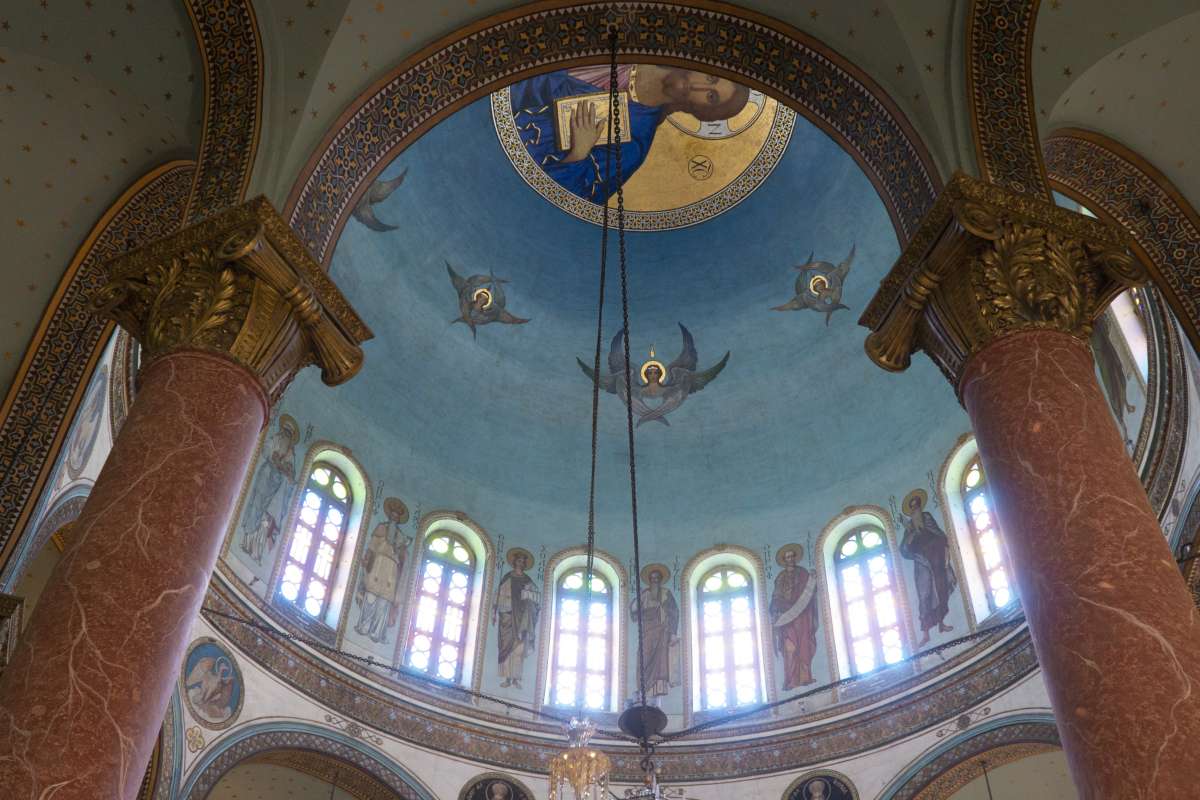
For many centuries, Alexandria was an example of multiculturalism and religious coexistence. In ancient times, it was home to Egyptian, Greek, Jewish, and Roman religions, while in later centuries, Muslim, Coptic Christian, and Jewish communities thrived. Even today, visitors can appreciate the diversity of beliefs that define the city’s character.
The Anfushi area, located between the great western port and the ancient eastern port, is the most distinctly Islamic part of Alexandria. Originally a commercial area, it was mainly populated after the Arab conquest and experienced great growth during Ottoman rule. While some of the mosques here are humble and in need of better conservation, the Abu al-Abbas al-Mursi Mosque stands out. Although built in the 20th century, it was built on top of an earlier mosque and is dedicated to the Sufi master Abu al-Abbas al-Mursi, originally from Al-Andalus (specifically from what is now the region of Murcia). He arrived in Alexandria in the 13th century, fleeing the Christian advance in Iberia, and died in the city. Today, his remains are preserved in this mosque, which is an important site for visitors interested in Islamic history and architecture.
The city of Alexandria also boasts a rich Coptic heritage that draws great interest from visitors. Some of the most important temples of this branch of Christianity, which is divided into several churches, can be found here, including the Coptic Church (or Coptic Orthodox), the Orthodox Church of Alexandria, and the Coptic Catholic Church. All of these churches trace their roots back to Saint Mark the Evangelist, who was the bishop of the city in the 1st century AD. The main Christian temples to see include:
Judaism also has a significant historical presence in Alexandria, although its followers lost much of their strength due to regional tensions following the creation of the State of Israel, causing many of them to emigrate. Currently, there are two synagogues in the city, with the most important being the Eliyahu Hanavi synagogue, which has recently been restored to its former glory.
Literature lovers worldwide are likely familiar with the city thanks to the works of some great writers who were inspired by its cosmopolitan social life over the last two centuries. For this reason, many people come to Alexandria as tourists and take a tour of the city center in search of places related to two main literary figures: Lawrence Durrell and Constantine Cavafy. Durrell was a British novelist who set his famous work, The Alexandria Quartet, in this city. And Cavafy was a Greek-born poet of great renown, whom Durrell also mentions in The Alexandria Quartet.
Here are some places you can add to your tour:
During your tour, you can also savor the atmosphere of the city center literally by visiting its cafes and pastry shops, reminiscent of what used to be meeting places for literati and artists. The Trianon pastry shop in Ramla Square, with its elegance and exquisite confections, is one of the best options for those with a sweet tooth visiting Alexandria. Unfortunately, many others have closed, such as Pastroudi’s Cafe, the refuge of Durrell’s characters, as well as the writer’s own refuge: his residence, Villa Ambron, which was demolished a few years ago.
You can also head to the eastern port to savor one of the city’s great gastronomic specialties: fish and seafood. The Fish Market or the Greek Nautical Club are some of the most recommended places, offering carefully prepared dishes in an elegant setting.
Alexandria is also one of the most interesting cities in Egypt when it comes to museums, not only related to Greco-Roman archaeology, but also with other themes. Of course, the most important one is the Greco-Roman Museum, a huge container of pieces and remains from the first centuries of the history of this city. Its façade evokes the great Greek temples and internally it is distributed around a large central courtyard. Around it, a large number of rooms are preserved with valuable pieces, such as a sacred bull Apis in black granite. There are also rooms dedicated to Alexander the Great, Cleopatra, and Mark Antony, with busts or coins showing their portraits. In addition, there are some areas dedicated to Egyptian culture, which was also respected and promoted by the Ptolemaic rulers, as well as Coptic Christian culture.
In addition to the Greco-Roman Museum and the Cavafis dedicated house-museum, there are other museums to consider for those who come to Alexandria for tourism:
While we have covered the main tourist attractions of Alexandria, there are many other interesting activities you can partake in during your stay. For example, scuba diving is a popular activity in the area, and there are companies that organize dives to explore underwater heritage just a few meters deep. You can observe works of art, palace statues, and other valuable objects from shipwrecks and military battles, or simply due to the advancement of the waters of the Mediterranean, wich have raised its level between 6 and 8 meters, making it a unique and unforgettable experience.
Therefore, there are companies dedicated to organizing dives of this type, and our agency can help you organize the experience. Some of the favorite underwater destinations are Cleopatra’s Palace, the remains of the lighthouse on Pharos Island, the nearby port city of Heracleion, and Abu Qir, where naval battles took place during the Napoleonic Wars between the French and British.
In addition to scuba diving, Alexandria has beautiful beaches where you can take a dip or relax. Although tourism in the city is not primarily focused on sun and sand, there are still options available, such as Stanley Bridge Beach. This small, private beach is located under the towers of the famous Stanley Bridge and is surrounded by a restaurant and shopping area.
If you’re looking for an exciting excursion from Alexandria, El Alamein is a must-visit destination. Located on the Mediterranean coast, El Alamein is famous for its historical significance during World War II, and it is home to moving memorials to the victims of the battles that took place here. Visitors can explore the War Museum to learn more about this critical military episode in 1942.
Aside from its historical significance, El Alamein is also home to beautiful beaches, many of which are private and linked to the resorts in the area. However, there are also other ways to enjoy these stunning beaches, and many tourists visit from Alexandria to experience them.
If you are planning a trip to Alexandria, here is some useful information to help you get around and make the most of your stay.
There are several ways to get to Alexandria, but the most common is by plane. While direct flights from foreign cities are limited, the city has year-round or seasonal flights from various destinations:
On the other hand, the most common option to get to Alexandria by plane is to have a layover in another local airport. These are the Egyptian cities connected by regular flights:
If you plan to include Alexandria as part of a larger tour of Egypt, taking the train is a convenient option. There are numerous connections with Cairo, and another line runs along the Mediterranean coast, connecting with other popular tourist destinations like El Alamein and Marsa Matruh. Although this option is mainly used by locals, it can be a great way to experience the scenery of Egypt.
Buses are another option to consider, with companies like Go Bus providing improved connections between Alexandria, Cairo, Luxor, and Port Said, among others.
However, the most comfortable, safe, and fast way to travel is by hiring a private vehicle with a driver. Egipto Exclusivo offers both excursion and multi-day trip options to explore Alexandria thoroughly. A 5-seat taxi or minivan can be arranged to suit your group size and preferences.
It is important to note that taking the ferry is not currently a viable option. The western port of Alexandria only handles commercial traffic and does not have passenger routes from other countries. However, in the past, the Venice-Alexandria route was operational, so it is not unlikely that certain routes will be resumed in the future.
If you’re planning to explore Alexandria, you’ll have several options for getting around the city. Our recommendation is to opt for a private taxi with a driver, as it’s the safest and most comfortable option. With a private taxi, you won’t have to worry about schedules or other inconveniences, and you’ll have the freedom to move around at your own pace.
If you choose to use the local taxi service, be prepared to put your bargaining skills into practice, as they usually don’t use meters and fares are agreed upon before the trip. As a rough guide, a ride from Midan Saad Zaghloul (next to the main tram station) to the Qaitbey Citadel could cost around 15 LE.
Alternatively, you can use public transportation to get around the city, but be prepared for some inconvenience. The tram network in Alexandria is extensive, but the trains are old and slow, and frequencies can be variable. The main station is Mahattat Ramla, located in Ramla Square (Midan Ramla). Microbuses are another option, but they are mostly used by locals and may not be the most convenient choice for tourists.
Overall, a private taxi is the best option for getting around Alexandria if you want comfort and convenience. However, if you’re on a budget, public transportation can be a good alternative, as long as you’re prepared for the slower pace and variable schedules.
If you’re looking to get information about the monuments and tourist attractions in Alexandria, you have limited options. Currently, there is only one tourist office in the city, located in Midan Saad Zaghloul near the Ramla station. However, they offer detailed information and maps about the city, which can help you plan your visits.
If you’re looking for a more convenient option and want to have an experienced agency take care of all the details of your trip, consider reaching out to Egipto Exclusivo. We can organize transportation, accommodation, restaurants, guided visits to monuments, and more. Our team will ensure that your trip to Alexandria is seamless and hassle-free. Don’t hesitate to get in touch with us for more information!


Fill out the form below to receive a free, no-obligation, tailor-made quote from an agency specialized in Egypt.
Travel agency and DMC specializing in private and tailor-made trips to Egypt.
Mandala Tours, S.L, NIF: B51037471
License: C.I.AN-187782-3